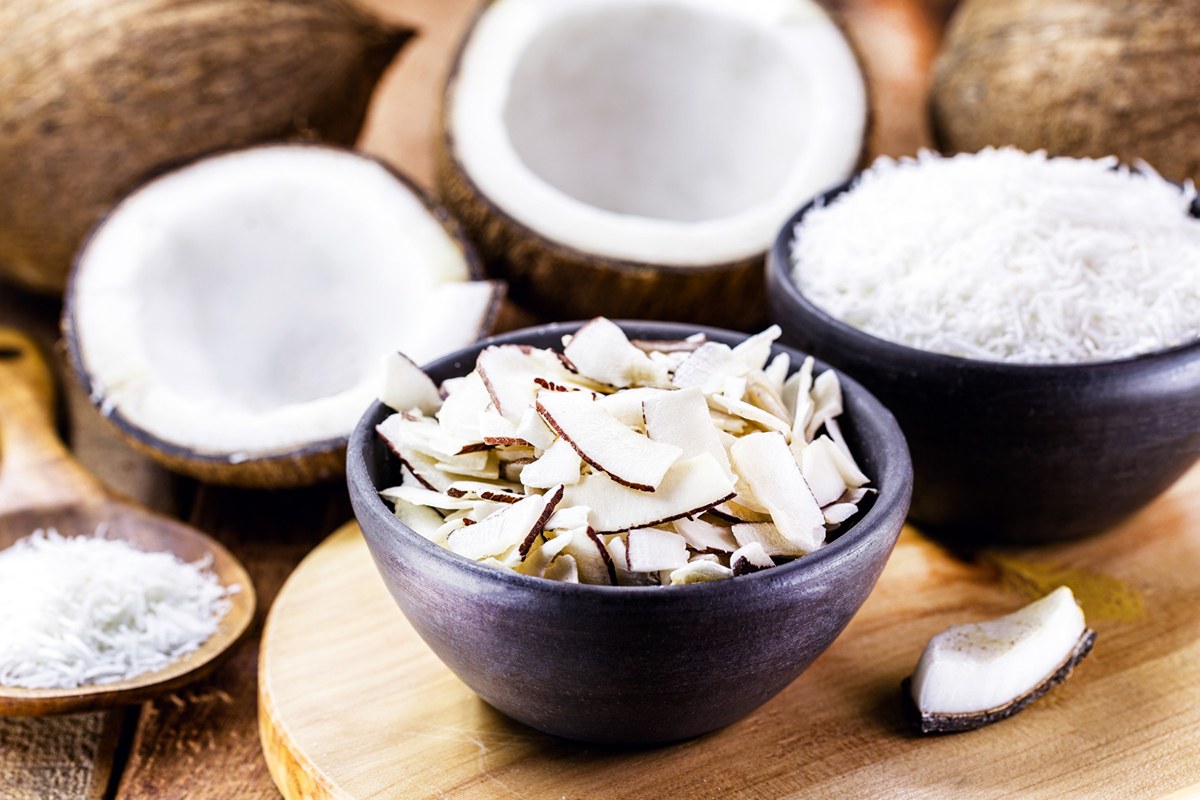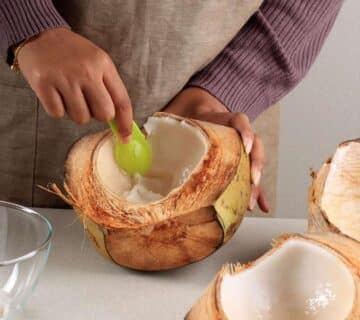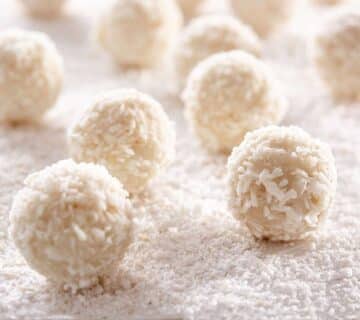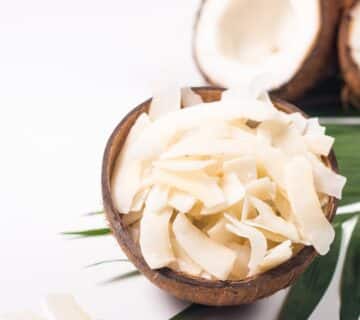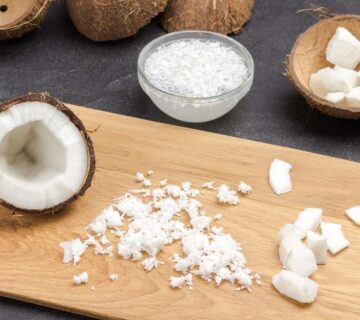In the culinary industry, desiccated coconut is a versatile ingredient used in various dishes, ranging from desserts to savory dishes. When it comes to desiccated coconut, there are two primary varieties: high-fat and low-fat.
While they may appear similar at first glance, there are significant differences in terms of fat content, flavor, aroma, texture, nutrition, and usage. Understanding these differences can help you choose the right type of desiccated coconut for your recipes.
The Difference Between High-Fat and Low-Fat Desiccated Coconut
There are two variants of desiccated coconut you should be aware of. Understanding the disparities between these two types of desiccated coconut is essential for selecting the perfect ingredient to elevate your culinary applications.
Let’s delve deeper into the key differences between high-fat and low-fat desiccated coconut across various aspects:
1. Fat Content
High-Fat Desiccated Coconut contains a higher percentage of coconut oil, which contributes to its richness and flavor. Typically, high-fat desiccated coconut contains around 60-70% fat. The higher fat content results in a more indulgent taste and texture.
In contrast, low-fat desiccated coconut has had a portion of its fat removed during processing. As a result, it contains a lower percentage of fat, usually around 45-50%. Removing some of the fat alters its texture and flavor profile, making it less rich and fatty compared to the high-fat version.
2. Flavor and Aroma
High-Fat Desiccated Coconut exhibits a more intense coconut flavor and aroma, thanks to the higher concentration of coconut oil. The flavor is robust and pronounced, enhancing the overall taste of dishes.
On the other hand, Low-Fat Desiccated Coconut offers a milder coconut flavor and aroma compared to its high-fat counterpart. The reduced fat content results in a subtler taste profile.
3. Texture
High-Fat Desiccated Coconut possesses a soft, moist texture that melts in the mouth. The higher fat content contributes to a smoother consistency, making it ideal for recipes where a creamy texture is desired.
Meanwhile, Low-Fat Desiccated Coconut features a drier, coarser texture due to the lower fat content. While it retains some moisture, it lacks the softness and creaminess of high-fat desiccated coconut.
4. Nutrition
High-Fat Desiccated Coconut is rich in saturated fats and calories, but also contains essential nutrients such as fiber, iron, and potassium. It offers a more concentrated source of energy due to its higher fat content.
Low-Fat Desiccated Coconut contains fewer calories and less saturated fat compared to high-fat desiccated coconut. While it may have slightly lower nutritional density, it still retains essential nutrients like fiber and minerals.
Here are the average nutritional information between high-fat and low-fat desiccated coconut:
| Nutritional Value
(per 100 gram) |
High-Fat Desiccated Coconut | Low-Fat Desiccated Coconut |
| Calories | 645 cal | 360 cal |
| Fiber | 10 gr | 16 gr |
| Free Fatty Acid | ≤ 0.1 % | ≤ 0.1 % |
| pH | 6.1 – 6.7 | 6.1 – 6.7 |
5. Usage
High-Fat Desiccated Coconut is best suited for recipes where a rich coconut flavor and creamy texture are desired. It works well in baked goods, desserts, and dishes where coconut is the predominant flavor.
While Low-Fat Desiccated Coconut is ideal for recipes where a lighter coconut flavor and drier texture are preferred. It can be used in a variety of baked goods and savory dishes, as well as sprinkled over salads or yogurt for added flavor and crunch.
6. Moisture Content
Due to its higher fat content, high-fat desiccated coconut may retain slightly more moisture compared to the low-fat variety. This can contribute to a softer texture and greater richness in recipes.
With a lower fat content, low-fat desiccated coconut may be drier and have a slightly firmer texture. This can affect how it behaves in recipes, particularly those where moisture content plays a significant role, such as in baking.
7. Shelf Life
The higher fat content in high-fat desiccated coconut can contribute to a shorter shelf life compared to the low-fat version. This is because fats can become rancid over time, especially if not stored properly. It’s important to store high-fat desiccated coconut in an airtight container in a cool, dry place to prolong its shelf life.
Due to its lower fat content, low-fat desiccated coconut may have a longer shelf life than the high-fat variety. However, proper storage is still important to maintain its freshness and prevent spoilage.
8. Cost
High-fat desiccated coconut may be slightly more expensive than the low-fat version due to its richer flavor profile and higher fat content. The additional processing required to extract and preserve the coconut oil contributes to its higher production costs.
Conversely, low-fat desiccated coconut is often more affordable since it undergoes less processing to reduce its fat content. This makes it a budget-friendly option for those looking to incorporate coconut flavor into their recipes without the higher price tag.
| Aspects | High-Fat Desiccated Coconut | Low-Fat Desiccated Coconut |
| Fat Content | 60-70% fat | 35-50% fat |
| Flavor | Richer and creamy | Lighter |
| Texture | Slightly softer | Drier and crispier |
| Nutrition | 645 calories / 100 grams | 360 calories / 100 grams |
| Usage | For rich and creamy fillings | For adding extra texture and richness |
| Moisture Content | ≤ 3% | ≤ 2,5% |
Which Desiccated Coconut You Prefer?
Whether you seek the rich, indulgent flavor of high-fat desiccated coconut or the lighter profile of its low-fat counterpart, both varieties offer unique characteristics to enhance your dishes.
As desiccated coconut finds its application across various industries, particularly in the food and beverage sector, the choice of a reliable supplier becomes important. For those seeking to procure premium-quality desiccated coconut and other coconut derivatives products, Sari Coconut emerges as the optimal choice.
As the leading certified supplier of Coconut Derivatives Products from Indonesia, Sari Coconut not only offers superior desiccated coconut but also an extensive range of coconut-derived products, including coconut oil, coconut charcoal briquettes, coconut sugar, coconut fiber, and more. With Sari Coconut, elevate your culinary creations and experience the richness of authentic Indonesian coconut products!
FAQ
Can I substitute high-fat desiccated coconut for low-fat desiccated coconut in recipes?
Yes, you can substitute high-fat desiccated coconut for low-fat desiccated coconut in recipes, but keep in mind that it will alter the flavor and texture of the dish. High-fat desiccated coconut will add a richer coconut flavor and creamier texture compared to low-fat desiccated coconut.
Is one type of desiccated coconut healthier than the other?
Both high-fat and low-fat desiccated coconut offer nutritional benefits, but the choice depends on your dietary preferences and needs. High-fat desiccated coconut is higher in calories and saturated fat, while low-fat desiccated coconut is lower in fat and calories. Choose the one that aligns with your dietary goals and tastes.
Can desiccated coconut be used as a substitute for fresh coconut?
Yes, desiccated coconut can be used as a substitute for fresh coconut in many recipes. However, keep in mind that the flavor and texture may vary slightly, so it’s essential to adjust the quantities accordingly.

